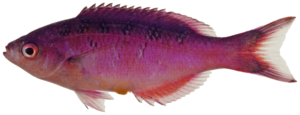Creole wrasse facts for kids
Quick facts for kids Creole wrasse |
|
|---|---|
 |
|
| Conservation status | |
| Scientific classification | |
| Synonyms | |
|
The creole wrasse (Clepticus parrae) is a beautiful and active fish. It belongs to the wrasse family and lives in the western Atlantic Ocean. These fish are known for their bright colors and how they change as they grow up.
About the Creole Wrasse
The creole wrasse is a small fish. Male creole wrasses can grow to about 30 centimeters (1 foot) long. Females are usually a bit smaller. They have a body shape typical of other wrasse fish.
One cool thing about them is how their colors change. Young creole wrasses are almost completely violet-purple. As they get older, a bright yellow patch appears on the back part of their body.
Where They Live
You can find the creole wrasse in the warm, tropical waters of the western Atlantic Ocean. Their home ranges from Florida all the way down to Brazil. They also live around the Bermuda Islands, in the Caribbean Sea, and in the Gulf of Mexico.
Their Daily Life
Creole wrasses are very social fish. They live in groups, often gathering on the slopes of coral reefs. They can be found in waters as deep as 100 meters (330 feet).
These groups of wrasses love to eat tiny creatures called plankton. Their diet includes small jellyfish, tiny snails called pteropods, and other small animals floating in the water. Creole wrasses are active during the day. When night comes, each fish finds a rocky spot or crevice in the reef to sleep alone.
How They Reproduce
Creole wrasses have a unique way of reproducing. They are what scientists call protogynous hermaphrodites. This means they are born female and can change into males later in life.
In a group of creole wrasses, the largest fish is usually the dominant breeding male. All the smaller fish in the group are females. If the main male dies, the largest female in the group will change sex and become the new dominant male.
When it's time to breed, the mature males gather in special areas called leks. Here, they perform displays to attract females. Females then approach the males, and they mate.


